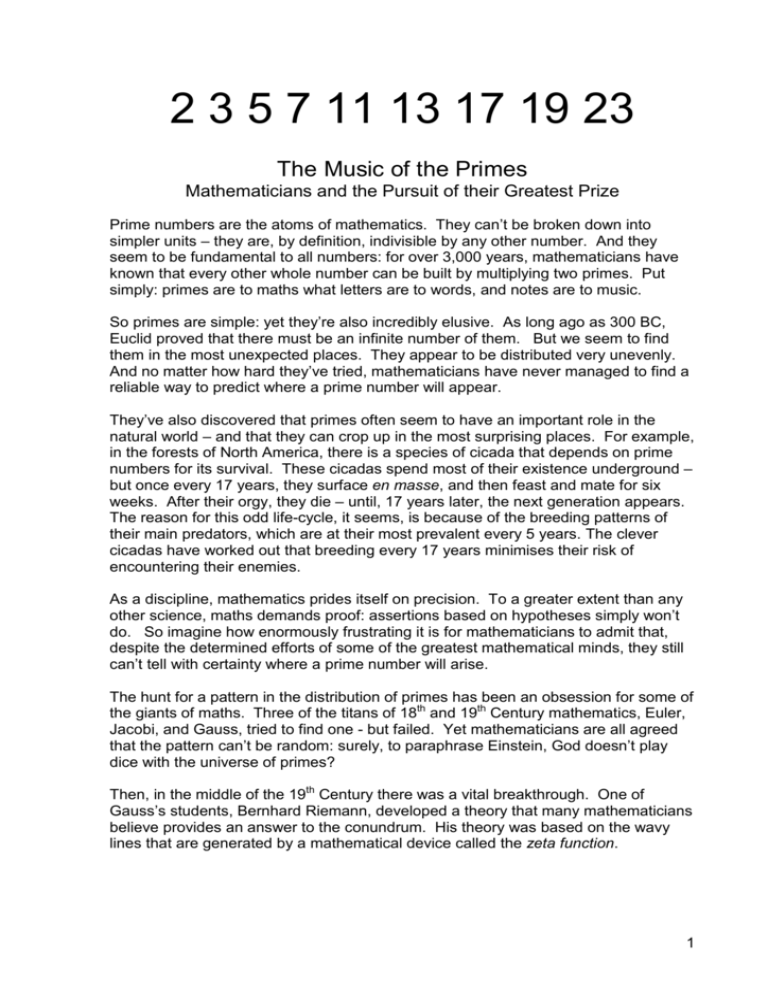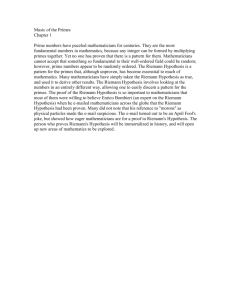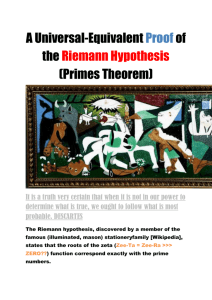The Music of the Primes - The Faculty of Mathematics, Computing
advertisement

2 3 5 7 11 13 17 19 23 The Music of the Primes Mathematicians and the Pursuit of their Greatest Prize Prime numbers are the atoms of mathematics. They can’t be broken down into simpler units – they are, by definition, indivisible by any other number. And they seem to be fundamental to all numbers: for over 3,000 years, mathematicians have known that every other whole number can be built by multiplying two primes. Put simply: primes are to maths what letters are to words, and notes are to music. So primes are simple: yet they’re also incredibly elusive. As long ago as 300 BC, Euclid proved that there must be an infinite number of them. But we seem to find them in the most unexpected places. They appear to be distributed very unevenly. And no matter how hard they’ve tried, mathematicians have never managed to find a reliable way to predict where a prime number will appear. They’ve also discovered that primes often seem to have an important role in the natural world – and that they can crop up in the most surprising places. For example, in the forests of North America, there is a species of cicada that depends on prime numbers for its survival. These cicadas spend most of their existence underground – but once every 17 years, they surface en masse, and then feast and mate for six weeks. After their orgy, they die – until, 17 years later, the next generation appears. The reason for this odd life-cycle, it seems, is because of the breeding patterns of their main predators, which are at their most prevalent every 5 years. The clever cicadas have worked out that breeding every 17 years minimises their risk of encountering their enemies. As a discipline, mathematics prides itself on precision. To a greater extent than any other science, maths demands proof: assertions based on hypotheses simply won’t do. So imagine how enormously frustrating it is for mathematicians to admit that, despite the determined efforts of some of the greatest mathematical minds, they still can’t tell with certainty where a prime number will arise. The hunt for a pattern in the distribution of primes has been an obsession for some of the giants of maths. Three of the titans of 18th and 19th Century mathematics, Euler, Jacobi, and Gauss, tried to find one - but failed. Yet mathematicians are all agreed that the pattern can’t be random: surely, to paraphrase Einstein, God doesn’t play dice with the universe of primes? Then, in the middle of the 19th Century there was a vital breakthrough. One of Gauss’s students, Bernhard Riemann, developed a theory that many mathematicians believe provides an answer to the conundrum. His theory was based on the wavy lines that are generated by a mathematical device called the zeta function. 1 Riemann’s Zeta Landscape As maths functions go, the zeta function isn’t especially complicated. But if you plot the zeta function graphically, it looks like a vast undulating landscape, studded with steeply rising hills and plummeting valleys. At his base in the University of Gottingen in Germany, Riemann discovered that if you can locate all of the places where the landscape dips to ‘sea level’, these points can be used to predict the behaviour of the primes. But rather than being randomly scattered around the landscape, Riemann noticed a fascinating pattern. The points seem to line up along some mysterious straight line in the landscape. Bernhard Riemann Riemann had discovered, it seemed, the mathematical Holy Grail: a formula to predict with certainty the distribution of primes. Well… not quite. Riemann had developed a fascinating hypothesis, by identifying a function that seemed to have real predictive power - yet he hadn’t provided a rigorous mathematical proof for any of it. Riemann is thought to have been closing in on a proof just before his death in 1866. But we’ll never know how close he was to providing a solution to the most perplexing problem in mathematics – because shortly after his demise, his housekeeper threw many of his unpublished manuscripts on the bonfire. Tantalisingly, there is evidence that a little black book used by Riemann to record his discoveries was among the papers that escaped the flames. But mysteriously, it has since disappeared from the archive. What survives of Riemann’s brilliant work has been a shot from a starting pistol, launching a race to find the proof that would unlock the strange secret that lies behind the distribution of the primes. Since Riemann’s demise, most of the world’s great mathematicians have grappled with this problem. David Hilbert, Alan Turing and Kurt Godel all tried. Even the extraordinary maths genius Srinavasa Ramanujan tried. But they all failed. Ramanujan’s case perhaps best illustrates the difficulty of the problem. By any measure, Ramanujan was a mathematical phenomenon. A penniless port authority clerk from the town of Erode in southern India, Ramanujan had no formal mathematical education. Yet after reading only one basic maths text book, he was able to reconstruct the entire history of Western maths – entirely on his own. 2 Srinivasa Ramanujan After being plucked from obscurity and penury by the distinguished mathematician G.F. Hardy, Ramanujan was brought to Cambridge, and there produced a startling number of original solutions to several ancient problems. But though he developed some important insights into the fundamental qualities of numbers, even the extraordinary Ramanujan could make only a limited contribution to the conundrum of the primes. But recently, the possibility of a real breakthrough has emerged – from an unlikely quarter. Research by quantum physicists has shown unexpected connections between the frequencies of Riemann's ‘music’ and the energy levels found in the nuclei of Uranium atoms. Riemann’s points and these subatomic quantum effects seem to share very similar and distinctive patterns. This surprise discovery was made during tea at the Institute at Princeton when a mathematician and a physicist were idly chatting. Perhaps quantum physics, rather than pure mathematics, will ultimately provide the answer to understanding the primes. Grasping the true nature of prime distribution remains elusive – but perversely, identifying primes that were once unimaginably huge is now routine stuff. By using supercomputers, and working collaboratively via the internet, prime hunters regularly discover some truly massive primes. The largest yet unearthed, in February 2005, is 225,964,951-1 - a number that is over 7.8 MILLION digits long. Yet frustratingly, a definitive proof still escapes the mathematical world. Perhaps this is just as well. If someone did produce a formula that would enable us to predict the distribution of primes, it would bring them global fame - and a $1 million prize. But it would also bring down the banking system as we know it, since all existing internet banking security systems are based on the unpredictability of prime distribution. The beguiling story of the search for a pattern in the primes is revealed in Marcus du Sautoy’s The Music of the Primes – a chronicle of the long struggle to find a solution to the most fundamental and frustrating puzzle in all mathematics. As a follow-up to his recent appearances on the BBC FOUR series Mindgames, we want du Sautoy to reveal the remarkable story of this epic pursuit – a 3,000 year-long story of mathematical joy and despair, frustration and insight, blinding light and blind alleys. It’s a journey that will take du Sautoy from ancient seats of learning in Greece, to the modern academic campuses of Gottingen, Princeton, and Cambridge. On the way, he’ll encounter swarms of cicadas in North America, the surviving relatives of Ramanujan in southern India, quantum physicists working with the huge atomsmashers at CERN in Switzerland, and two extraordinary autistic patients of the psychiatrist Oliver Sacks – twins, whose only form of communication involves the exchange increasingly large prime numbers. Like du Sautoy’s book, this film will describe this great intellectual enterprise in an intelligent yet thoroughly accessible way. He’ll couple the powerful central narrative of this great intellectual battle with compelling visual metaphors, and will relate key episodes in the lives of the great mathematicians who’ve sought the answer to the 3 problem of the primes. In a film richly illustrated by rare archive footage, and original location filming, we’ll use the latest computer-generated imaging technology to produce an ambitious, spectacular three-dimensional graphical representation of Riemann’s zeta landscape, to map the ancient pursuit of the most precious prize in mathematics. David Okuefuna BBC Arts March 2005 4









